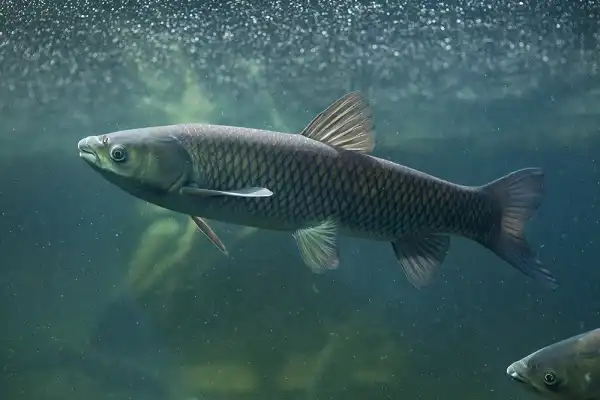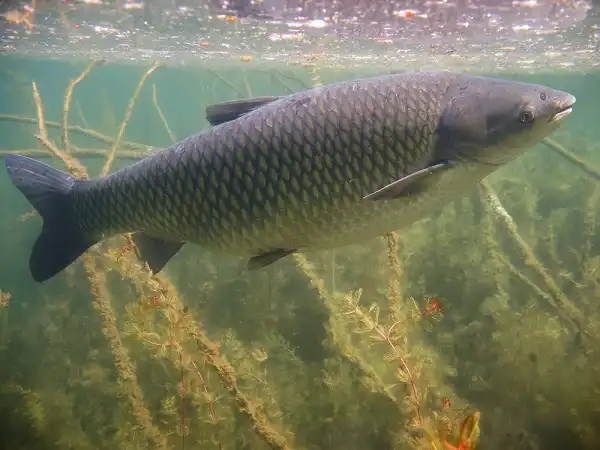Grass carp, also known as white amur, are becoming more and more popular in the aquaculture industry. These hardy fish have a wide range of uses, from controlling unwanted vegetation in ponds to providing nutrient-rich sources of food. Learn about the impressive traits and benefits of grass carp here – from their biology to how they can provide substantial help for pond owners everywhere!

Grass Carp Description
Grass carp, scientific name Ctenopharyngodon idella, are a species of freshwater fish that belong to the family Cyprinidae. They are native to eastern Asia, specifically China and Russia, and have been introduced to many other countries for their usefulness in the aquaculture industry. Grass carp are known for their distinctive appearance, with a long, cylindrical body that is typically silver or gold in color. Grass Carp have a cylindrical body shape, with a long, slender body and a slightly arched back. However, their body shape can be affected by their diet, so if they are fed too much, they may take on a more rounded appearance. Overall, grass carp are a fascinating species that offer a wide range of benefits to both the environment and humans. With their hardiness, adaptability, and unique characteristics, it’s no wonder they are becoming increasingly popular in the aquaculture industry.
Grass Carp Habitat
Grass carp are native to the freshwater rivers of eastern Asia, particularly China and Russia. They have since been introduced to various other countries for their use in managing aquatic vegetation and as a food source. Although they can tolerate a wide range of temperatures, they prefer warm, slow-moving water with vegetation to graze on. Grass carp can thrive in a variety of aquatic environments, including lakes, ponds, and rivers with slow to moderate currents. Their ability to consume large amounts of vegetation makes them a valuable asset in managing aquatic weed overgrowth in these environments. In order to maintain healthy populations, grass carp require adequate space and water quality. They typically prefer waters with neutral to slightly alkaline pH levels and moderate to high dissolved oxygen levels. Water temperature plays a crucial role in their development and growth. Grass carp thrive in warm water environments and are less active in cooler temperatures.
Grass Carp Diet
The Grass Carp’s diet primarily consists of aquatic plants such as waterweed, pondweed, and duckweed. They are known for their remarkable ability to consume vast amounts of vegetation, which makes them a popular choice for pond owners who want to control unwanted vegetation without using harmful chemicals. In the wild, their diet may also include algae and small invertebrates like insect larvae. In captivity, the Grass Carp diet may vary slightly, but they still require a plant-based diet to stay healthy and thrive. They enjoy fresh vegetables such as lettuce, spinach, and peas, as well as fruits like apples and oranges. Some commercially available feeds for Grass Carp contain a mixture of plant proteins, grains, and vitamins. It is worth noting that Grass Carp are herbivorous and should not be fed meat-based diets as this can lead to severe health issues. It is also essential to feed them the right amount of food as overfeeding can lead to obesity and affect their overall health.

Grass Carp Size
Grass Carp are a large species of freshwater fish that can grow to impressive lengths and weights. The maximum recorded size of a Grass Carp is up to 1.5 meters (4.9 feet) in length and up to 45 kilograms (100 pounds) in weight. However, these are exceptional sizes, and most Grass Carp typically grow to around 60-90 centimeters (2-3 feet) in length and weigh around 4-9 kilograms (9-20 pounds). Several factors can influence the size of Grass Carp, including genetics, environmental conditions, and diet. In ideal conditions, Grass Carp have the potential to reach their maximum size, but most fish are commercially farmed and do not grow as large as wild Grass Carp. The growth rate of Grass Carp varies depending on several factors, including water temperature, food availability, and genetic traits. Typically, Grass Carp grow quickly during their first year of life, with growth rates slowing down as they get older. In warm water environments, Grass Carp can grow up to 1-2 pounds per year.
Grass Carp Lifespan
Grass Carp have a relatively long lifespan, especially for a fish species. They usually live for around 5-9 years in the wild but can live up to 15 years in captivity under ideal conditions. However, their lifespan can vary depending on several factors, including genetic traits, environmental conditions, and availability of food. In addition, their lifespan can also be affected by disease, predation, and human activities like overfishing. Grass Carp reach sexual maturity at around 2-3 years of age, which is relatively late compared to other fish species. They typically reproduce during the spring and summer months, and females can produce up to 1 million eggs per year. However, only a small percentage of these eggs tend to survive to adulthood, as many are eaten by other fish or fail to hatch. Overall, the Grass Carp is a fascinating fish species known for its impressive size, herbivorous diet, and long lifespan. While their lifespan can vary depending on several factors, they can live up to 15 years in captivity under ideal conditions. Their resilience and adaptability have also made them an important species for controlling unwanted vegetation in ponds, lakes, and other freshwater environments.

Grass Carp Behavior
Grass Carp are known for their unique behavior, which is influenced by several factors including genetics, environment, and diet. They are generally docile and peaceful fish, and can often be found swimming in large schools. However, their behavior may change if they feel threatened, or if they are in breeding mode. During the breeding season, Grass Carp become more territorial and aggressive, especially males who compete for the attention of females. They may also become more elusive during this time, hiding in vegetation or near the bottom of the water to avoid predators or other threats. Another unique behavior of Grass Carp is their jumping ability, which they use as a defense mechanism. When threatened or disturbed, they can jump several feet out of the water to escape predators or other perceived threats. This behavior can also make them a hazard for boaters and humans, as they may accidentally jump into boats or injure people with their sharp spines.
Grass Carp Speed
Grass Carp are not particularly fast fish, as their diet and behavior do not require them to be. They are adapted for slow and steady movement, allowing them to leisurely graze on aquatic vegetation and plants. Their average swimming speed is between 1-2 miles per hour, although they are capable of short bursts of faster swimming when threatened or disturbed. Despite their lack of speed, Grass Carp have some unique adaptations that allow them to navigate through their environment more efficiently. For example, they have a streamlined body shape that reduces drag and makes swimming more efficient. They also have a specialized swim bladder that can expand or contract to control their buoyancy, allowing them to move up or down in the water column without using much energy.
Grass Carp Hunting
Grass Carp are not typically known for actively hunting other fish or aquatic animals, as they have a primarily herbivorous diet. However, there have been some reports of Grass Carp occasionally consuming small fish and invertebrates, particularly when other food sources are scarce or unavailable. In general, Grass Carp are more likely to be hunted than actively hunted. They are preyed upon by a variety of aquatic predators, including larger fish, birds, reptiles, and mammals. However, their large size and tough, scaly exterior provide some protection against predation. Grass Carp are also sensitive to changes in their environment, and may be affected by changes to water quality, habitat degradation, and other human activities. Overfishing and habitat destruction can reduce the availability of food and shelter for Grass Carp, making them more vulnerable to predation and other threats.

Conclusion
Grass Carp are an interesting and unique species of fish that have adapted to freshwater environments around the world. Their slow and steady swimming speed, herbivorous diet, and unique feeding behaviors make them fascinating species to observe and study. They may not be the fastest or most aggressive hunters in the water, but their presence is important for maintaining healthy aquatic ecosystems. Human activities can greatly affect their populations and the availability of food resources, so it is important to take measures to protect Grass Carp populations from habitat destruction and overfishing. By understanding more about this species we can better appreciate their role in our freshwater ecosystems and ensure they continue to thrive for years to come.
Frequently Asked Question


